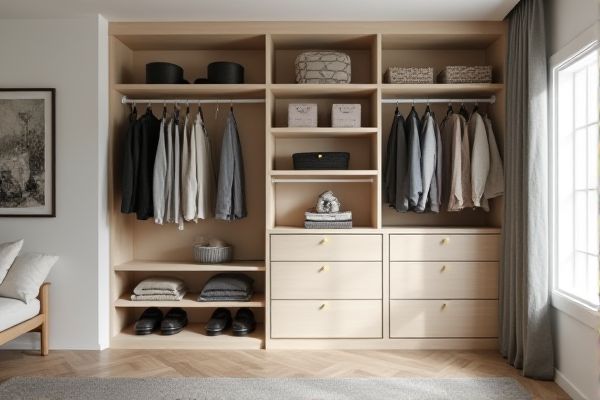
Closet depth determines how much hanging space and storage capacity you have, while closet width affects how many items can be stored side by side and the overall accessibility. Understanding the balance between closet depth vs closet width is essential for optimizing Your space efficiently--continue reading to discover which dimension suits your storage needs best.
Table of Comparison
| Aspect | Closet Depth | Closet Width |
|---|---|---|
| Definition | Distance from front to back of the closet | Distance from one side wall to the other |
| Standard Range | 24 to 30 inches (61 to 76 cm) | 36 to 72 inches (91 to 183 cm) or wider |
| Primary Function | Provides hanging and storage depth | Determines total accessible storage space |
| Ideal for Hanging Clothes | Minimum 24 inches for hangers | Wider width allows more hanging rods and shelving |
| Space Efficiency | Too deep can waste space; too shallow limits hanging | Wider closets maximize storage but need more room |
| Customization Impact | Adjusting depth changes storage type (double rods, shelves) | Adjusting width affects number of compartments and accessibility |
Understanding Closet Dimensions: Depth vs Width
Closet depth typically ranges from 24 to 30 inches, designed to accommodate hangers and clothing without crumpling garments, while closet width varies widely based on available wall space and storage needs, often spanning from 36 inches to several feet. Proper understanding of closet dimensions ensures optimal use of space, allowing for efficient organization and accessibility of clothing and accessories. Prioritizing depth for hanging space and width for storage capacity creates a balanced and functional closet layout.
Why Closet Depth Matters for Storage
Closet depth significantly impacts storage capacity by determining how much you can fit without overcrowding or damaging items. A standard closet depth of 24 inches accommodates most hanging clothes, while deeper closets allow for additional shelves and bins, maximizing organization. Ensuring your closet depth suits your storage needs helps you optimize space and accessibility for your belongings.
The Role of Closet Width in Organization
Closet width plays a crucial role in maximizing storage capacity by allowing for multiple hanging rods, shelving units, and drawers, which improves overall organization. A wider closet accommodates a variety of clothing types and accessories, making it easier to categorize and access items without overcrowding. Optimal closet width enhances visibility and accessibility, reducing clutter and streamlining daily outfit selection.
Standard Closet Depth Measurements
Standard closet depth measurements typically range from 24 to 30 inches, allowing sufficient space for hanging clothes without causing them to bunch up. Closet width varies widely depending on room size and design but usually starts at 36 inches for reach-in closets, expanding to several feet for walk-in models. Prioritizing depth ensures garments hang properly, while width accommodates overall storage capacity and organizational options.
Typical Closet Width Ranges
Typical closet widths range from 24 to 72 inches, providing flexibility based on room size and storage needs. Narrow closets around 24 to 36 inches are ideal for small spaces or single-person use, while wider closets of 48 to 72 inches accommodate double hanging rods and more extensive storage options. Optimizing closet width is crucial for organizing clothes and accessories effectively without compromising room layout.
Choosing the Right Depth for Your Clothing
Closet depth plays a crucial role in ensuring your clothing fits properly without causing damage or overcrowding; the standard depth for hanging clothes ranges from 24 to 30 inches, allowing garments to hang freely without wrinkling. Shallow closets (12-18 inches) are ideal for folded clothes or accessories but can lead to clothing pressing against doors if used for hanging items. Prioritizing closet depth over width ensures better garment maintenance and usability, especially when storing bulkier items like coats or suits.
Maximizing Usable Space with Proper Closet Width
Maximizing usable space with proper closet width involves selecting a measurement that accommodates hangers and clothing without overcrowding. A closet width of 24 to 30 inches allows for easy access and optimal garment storage, preventing clothes from wrinkling or becoming difficult to reach. Ensure your closet width matches the types of clothing you store to enhance organization and overall functionality.
Custom Closets: Balancing Depth and Width
Custom closets require precise balancing of depth and width to maximize storage efficiency and accessibility. Ideal closet depth ranges between 24 to 30 inches to accommodate standard hangers while preventing clothes from getting crushed or wrinkled. Width should be customized based on room dimensions and storage needs, ensuring enough space for shelves, drawers, and hanging rods without overcrowding the area.
Closet Depth and Door Types: What to Consider
Closet depth directly influences the type of doors that can be installed, with sliding or barn doors requiring less clearance than hinged doors, which need extra space to swing open. Standard closet depths typically range from 24 to 30 inches, accommodating most door types and providing enough room for hanging clothes without causing obstruction. Choosing the right closet depth based on door type ensures functionality and maximizes usable space within the bedroom or hallway.
Tips for Optimizing Closet Layout Based on Dimensions
Maximize closet efficiency by balancing depth and width according to your storage needs; a standard closet depth of 24 inches accommodates most hangers, while increasing width allows for more hanging space and shelving. Utilize adjustable shelving and double-hang rods to make the most of narrow or deep closets without overcrowding. Your optimal closet layout should consider accessibility and the types of items stored, ensuring that both dimensions work together to enhance organization and ease of use.
 homyna.com
homyna.com